|
This should be a great build so I'm in. Y'all are going to start costing me more money I see already. :)
|
|
|
It is foolish and wrong to mourn the men who died. Rather, we should thank God that such men lived.
General George S. Patton, Jr. |
|
That’s an impressive pile of parts👍
The one caution I’d advise is be careful of your lightening cuts, I’ve seen many slides with impressive looking cut that cracked On your open gun slide I wouldn’t go lighter than 10.5oz I got a question on your caspian commander slide, did it come milled for the optic? |
|
|
|
|
Nice. Is the frame of commander aluminum also? I assume so since you said lightweight build.
|
|
|
|
|
Is the frame on the commander aluminum? No, it is carbon steel. The grips are aluminum.
Slide lightening - thanks for the advice. The overall design is from cheely, back when they accepted custom builds. I'm undecided on the final design yet, keeping overall weight in mind and trying to not get too aggressive. Did the Caspian come with the red dot cut? Yes, it is a factory option that they just don't have advertised. It fits the Trijicon RMR adapter plate (pictured.) |
|
|
|
|
Thanks the info, I was wondering when caspian would start offering that as an option, how much did they charge for the cut
|
|
|
|
|
Nice build, following for updates.
|
|
|
"Opinions are like assholes - everybody is one"
"Fast cars drag-race, fast drivers road-race" |
|
Very nice OST.
|
|
|
GGG Farms: https://www.youtube.com/channel/UCplCGUdcAmy59r3W5Ls_DlQ
|
|
This is really cool. I always wanted a cheely grip for my staccatos. Following this thread.
|
|
|
|
|
Looking GREAT Lee, Congrats.
So what did you think of the lapping compound? would you do it that way again ? Larry |
|
|
|
|
Originally Posted By Larrys1911: Looking GREAT Lee, Congrats. So what did you think of the lapping compound? would you do it that way again ? Larry View Quote I certainly would. I had some concerns that the diamond might embed into the steel and persist, but it doesn't look like it happened. The action is silky smooth and tight, maybe still too tight. Once everything is together and testing begins I'll know whether some things need to be opened up. Made some progress on the barrels this past week, will post some more soon. Also made one small design change. The sears will have a true radius cut on them, instead of a traditional. Wanted to try that for the first time. |
|
|
|
|
The barrels are in the works. Some more milling is needed for the government (cutting down the muzzle and putting a slight angle on it). The Brazos Custom Build Your Own Gun writeups have been particularly helpful in regards to the one piece barrel-with-compensator since there isn't a whole lot of information out there and the slight angle on the muzzle honestly completely escaped me during pre-planning. Though I guess the same effect could be had by cutting the rear of the compensator, I'll trust the professional opinion on this one.
Both triggers needed some work in order to fit onto the grips properly. The trigger in the aluminum grip needed the width of the grip opened up. 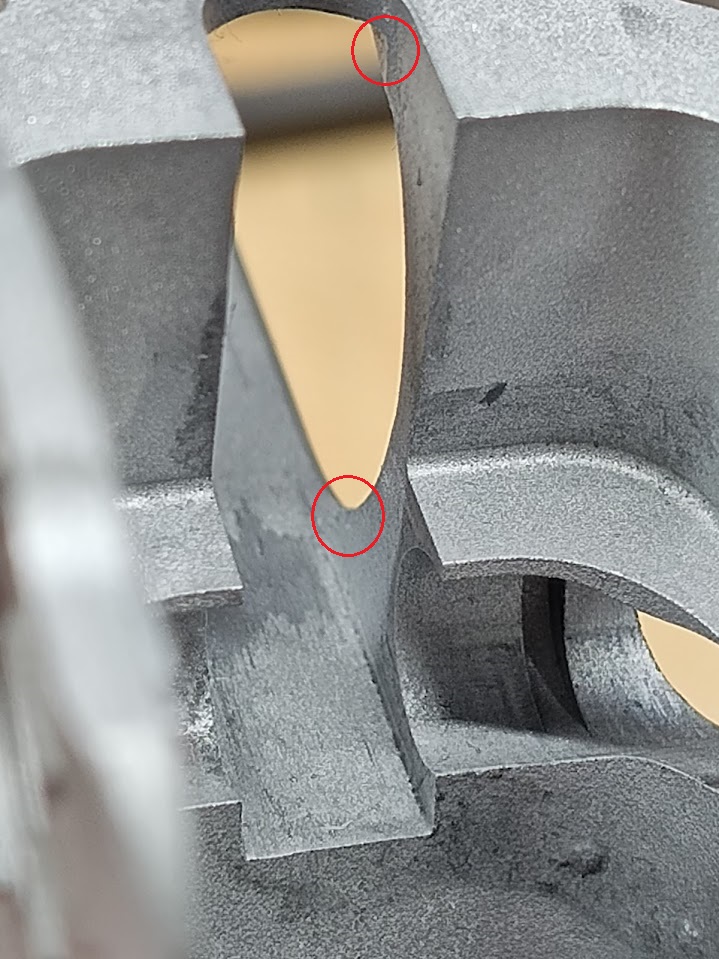 There are several small areas in the corners that Cheely has left oversized so that they can be fitted to the width of the trigger. 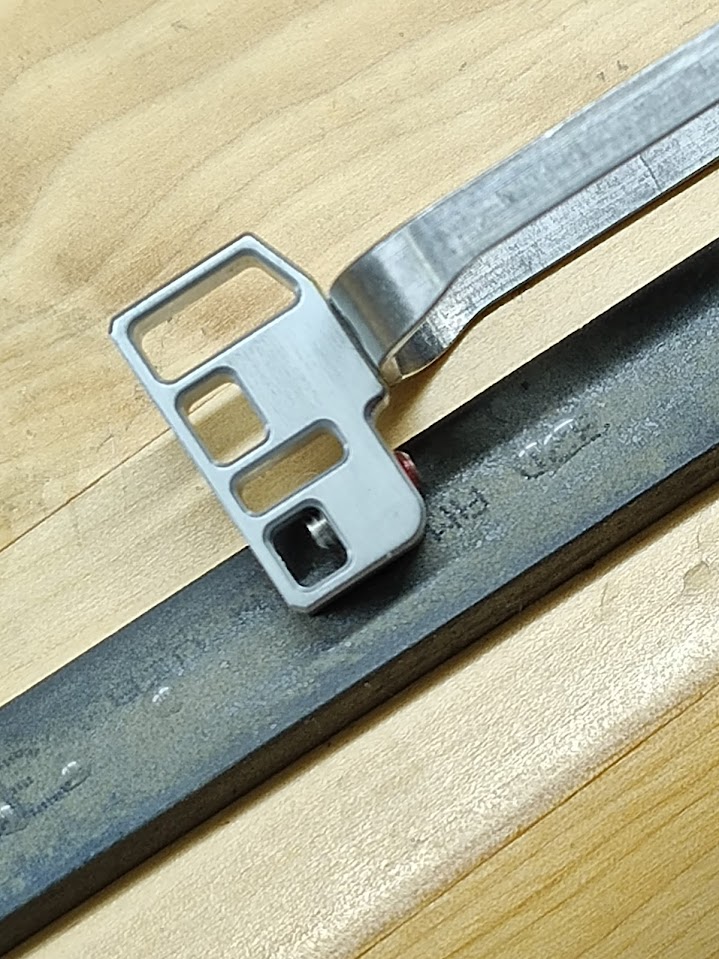 For the steel grip, the width was already perfect, but the trigger shoe was too tall. Several passes on a 320 grit stone on the top and bottom quickly fitted the trigger to the opening. 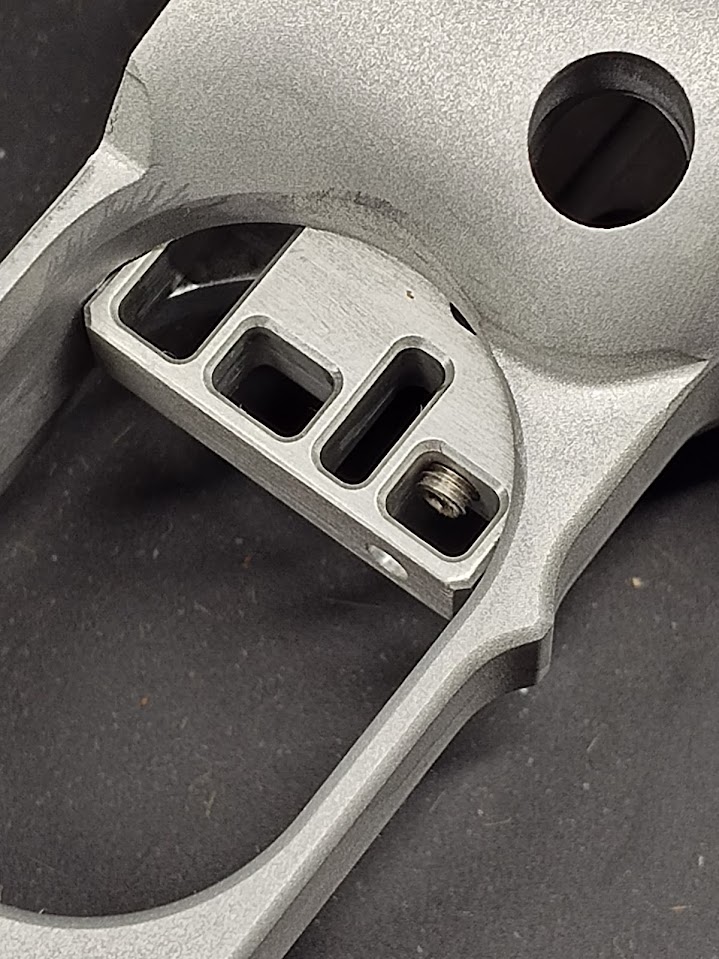 After the triggers were both close to fitting into the grips, I used 600 and 800 grit stones to smooth over any touching surfaces on the grip. The result is a smooth trigger pull without any snags. The frame safeties were next to contour. They shouldn't be fitted to the sear until the work on the sear is completed. I'm going to give the True Radius a try on both sears, so while I did practice a little with the stones on the primary sear angle, the True Radius fixture is still in the mail. The safeties are EGW HD. The contour of the safety is my preferred style (as opposed to the Springfield Armory, Les Baer, Wilson Combat, etc. which are much more curved and pointed) but there is an interference issue with the frame at the bottom. 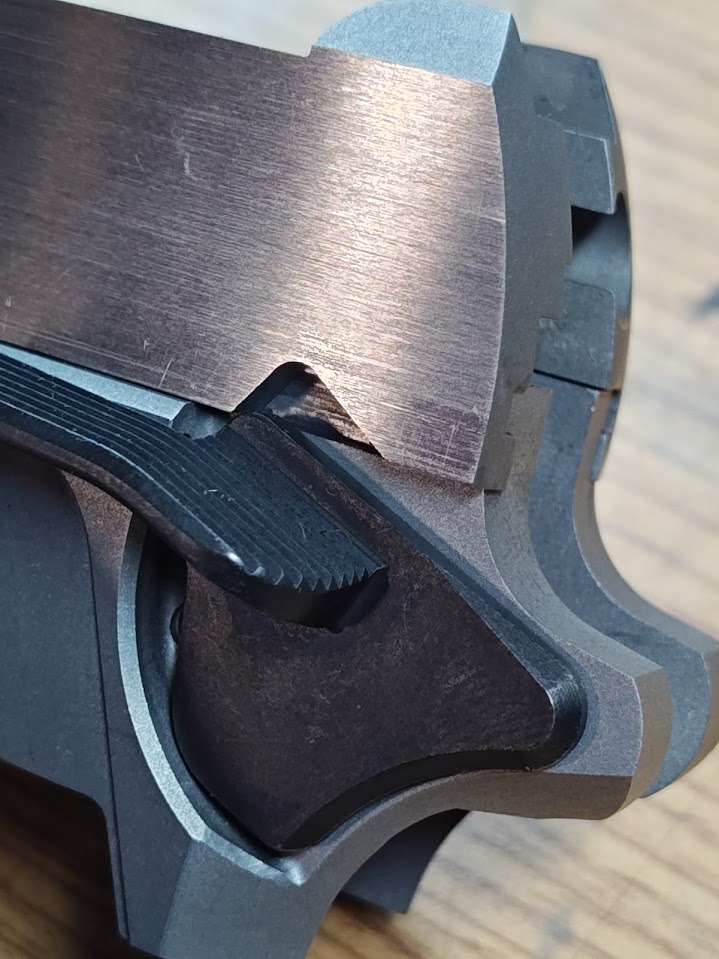 The slide interference issue aside, the bottom of the safety is contacting the frame. 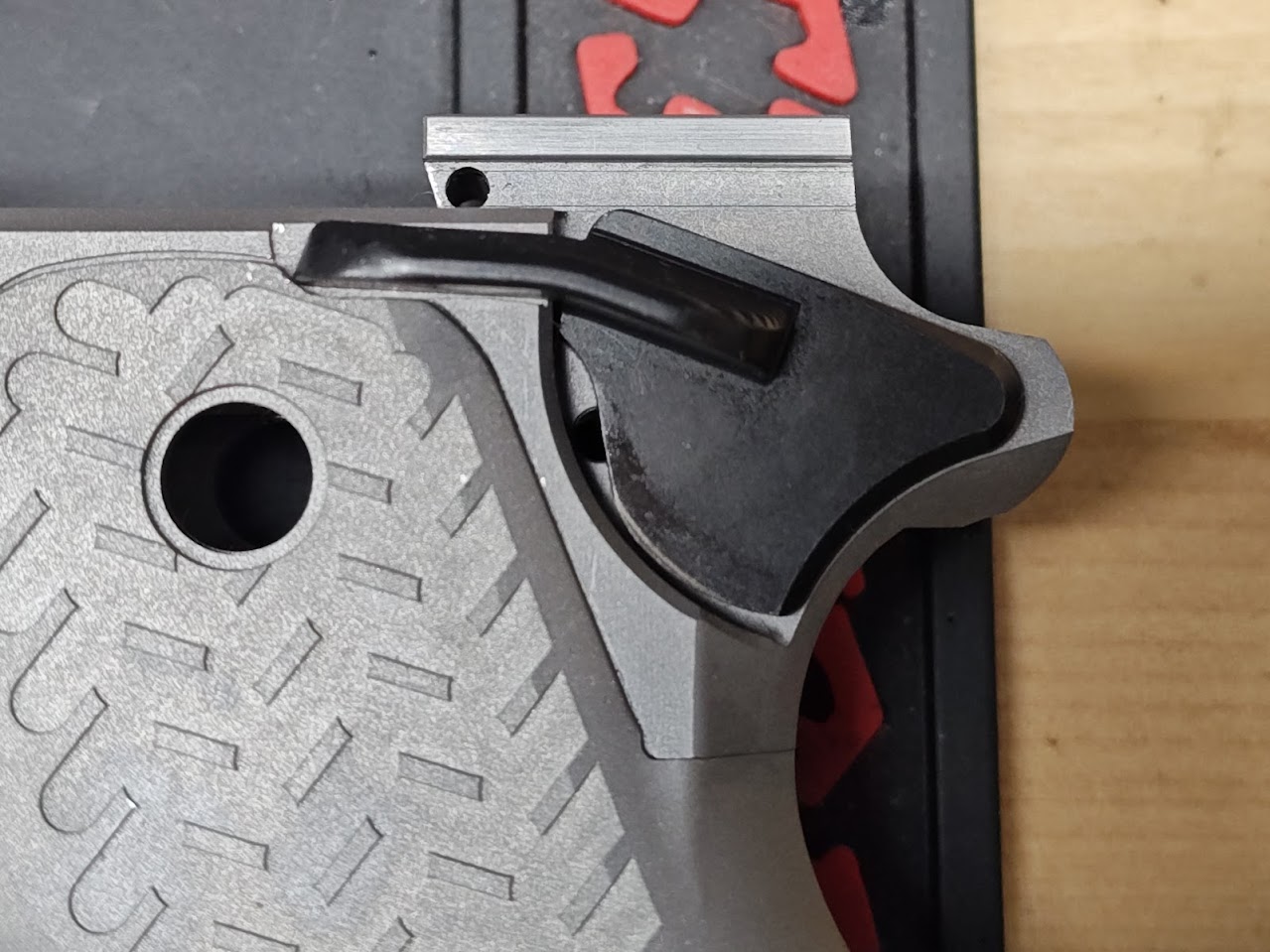 I used the smallest diameter brass punch I had to scribe a line across the bottom of the safety parallel with the frame, then used a fine grit belt sander to slowly walk the edge up to the line. A little bit of stoning on the edges to remove the burr and it looks like this. 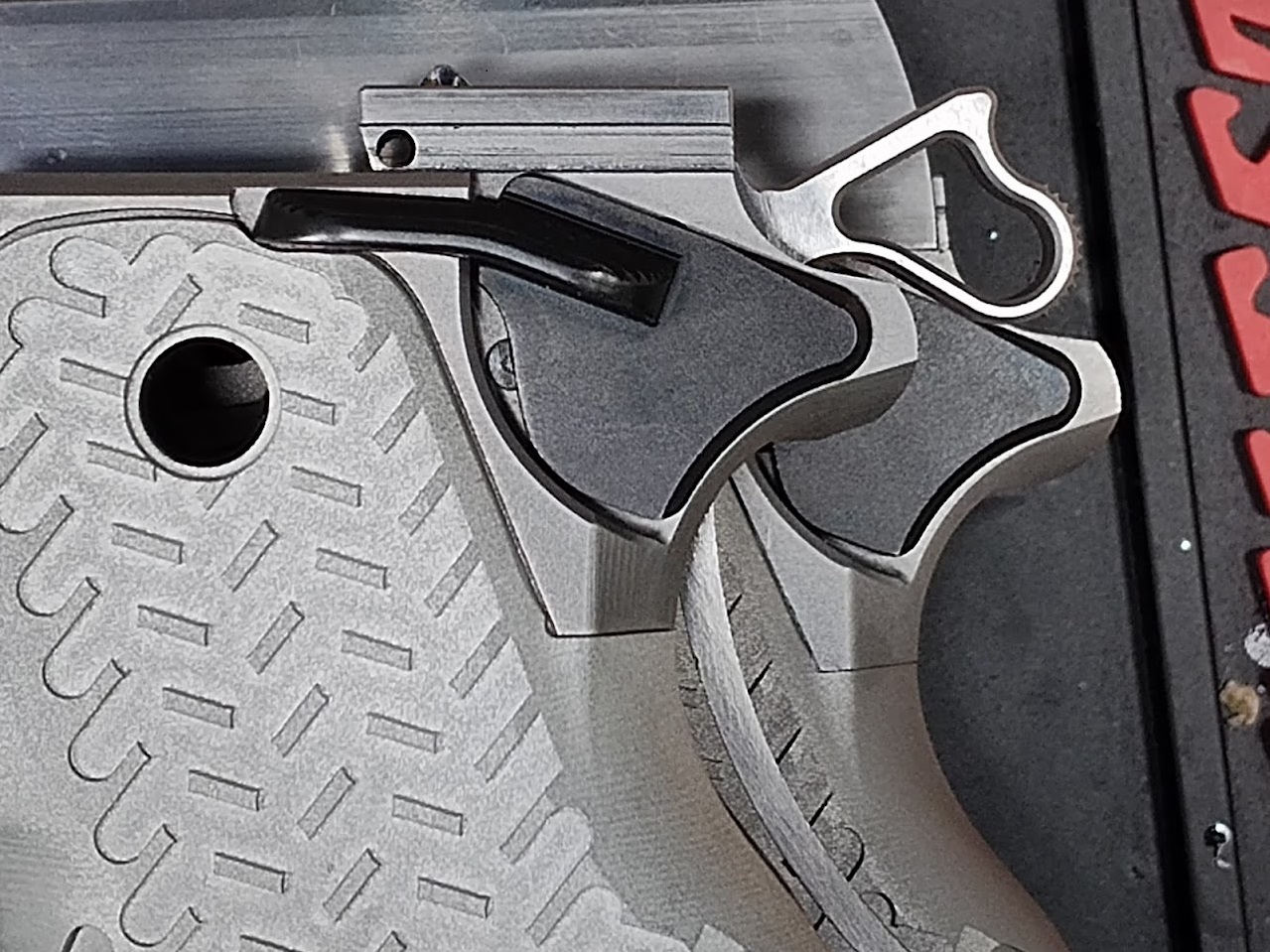 Before (background) and after (foreground) |
|
|
|
|
Hey Lee, AWESOME well done. Wouldnt have thought of the angle on the slide either since I have never done one.... You just make me want to buy a little Mill.
|
|
|
|
|
Are you using Red Dirt triggers?
|
|
|
Make sure you tell guys that the 1911 is a pain in the ass - Larry Vickers
|
|
|
|
Originally Posted By leelaw: Good eyes. Yes, Red Dirt flat, Cheely frame profile triggers. View Quote |
|
|
Make sure you tell guys that the 1911 is a pain in the ass - Larry Vickers
|
|
Originally Posted By Bradd_D: I recently put a Red Dirt in my Staccato. I need to figure out how to tighten up the play up and down. https://www.ar15.com/media/mediaFiles/2261/20240113_185634_jpg-3093783.JPG View Quote had a frame that was cut over size in the verticle trigger shoe area once, I carefully Peened the trigger shoe (Center punch several times - it raises the metal surface creating a kind of burr) itself on both top and bottom, wasnt pretty but it worked. Youll have to refit it probably and stay away from the edges or you can screw it up, IMO several center small punch hits work better than a few deep ones I work on the road and bought a Rock Island 10mm and the stock trigger shoe was steel and way undersized, since we had three day weekend and I was too far to drive home I had nothing to do and bought JB weld peened the up and down again (that wasnt enough) and put a very small amount of it on the shoe, it worked but its a PITA and JB weld is kinda sticky so if I was doing it on something i really Cared about I would use a different epoxy. I did this while waiting for a Wilson trigger to be delivered because I was bored, never had any intention of it staying in the gun, it was too heavy to start with and adding more weight was not helping. They make aluminum triggers for a reason. Trigger bounce IS a thing. I just wanted to see what I could do with it. If you are talking about the trigger track itself being too large for the bow take a small sharp center punch and dimple each corner on the top part (youre trying to create a raised area on the edge of the bow to take up space vertically) on the in each of the four corners, obviously you have to have some type of blocking inside the bow to do this. In all honesty I wouldnt do either of these unless I had no choice, They work fine and you cant tell unless you disassemble the gun and pull the trigger out but its SUCH A PITA to do when you can just buy a trigger that fits. Ok there is the quick and dirty methods. This is the one I would use if I just had to have a certain trigger that was too big or if the track was just cut too large. If you have a drill press and are good with your hands this is the method used by the pros and is definately prefered. you drill a hole or couple in the top and or bottom of the shoe just deep enough to hold a delrin rod (sorry dont remember the size off the top of my head) you drive the delrin rod in and trim it/them to fit.... Easy peezy :) Id MUCH rather have a gun that was on the small side of tolerances than the large side. |
|
|
|
|
Originally Posted By Larrys1911: This is the one I would use if I just had to have a certain trigger that was too big. If you have a drill press and are good with your hands this is the method used by the pros and is definately prefered. you drill a hole or couple in the top and or bottom of the shoe just deep enough to hold a delrin rod (sorry dont remember the size off the top of my head) you drive the delrin rod in and trim it/them to fit.... Easy peezy :) Id MUCH rather have a gun that was on the small side of tolerances than the large side. View Quote |
|
|
Make sure you tell guys that the 1911 is a pain in the ass - Larry Vickers
|
|
Originally Posted By Bradd_D: That's what I've been considering. With the trigger track being in the plastic grip, I don't want to do anything that will create drag by digging into the plastic, i.e. set screws, peening, etc. View Quote It's a much more time consuming proposition, but what about dovetailing a bit of brass (to extend the height of the trigger bow) into the steel of the bow, then filing, sanding and polishing that to size? It's still a harder material than the polymer, but would provide a much smoother surface than a peened edge. The bow on these are not as tall as the corresponding channel in the frame, but because the trigger shoes are so closely fitted and running smoothly, I don't feel much lift at all. Of course, more testing is needed. |
|
|
|
|
Really do appreciate the updates and the time taken to post all the work.
|
|
|
BikerNut:
Normal people like motorcycles. Real people like motorcycles. People who don't like motorcycles are just... weird. |
|
This is an amazing thread! Thank you for sharing the details.
|
|
|
|
|
This is awesome! And a tag for future updates.
|
|
|
|
|
The prior mention of fitting an ejector has skipped some details. After hand-filing one gunsmith-fit ejector to fit, I wasn't convinced the juice was worth the squeeze. I'll get a post set just to compare the gunsmith fit to the minimally fit long ejector sometime later. I'm a bit behind on updates as my free time is getting chewed into. Ah, life....
Anyways, on to some sear and hammer sets. On both of these, I'm modifying both of the EGW sears to have a True Radius across the sear surface. The hammers are both C&S Super Match. 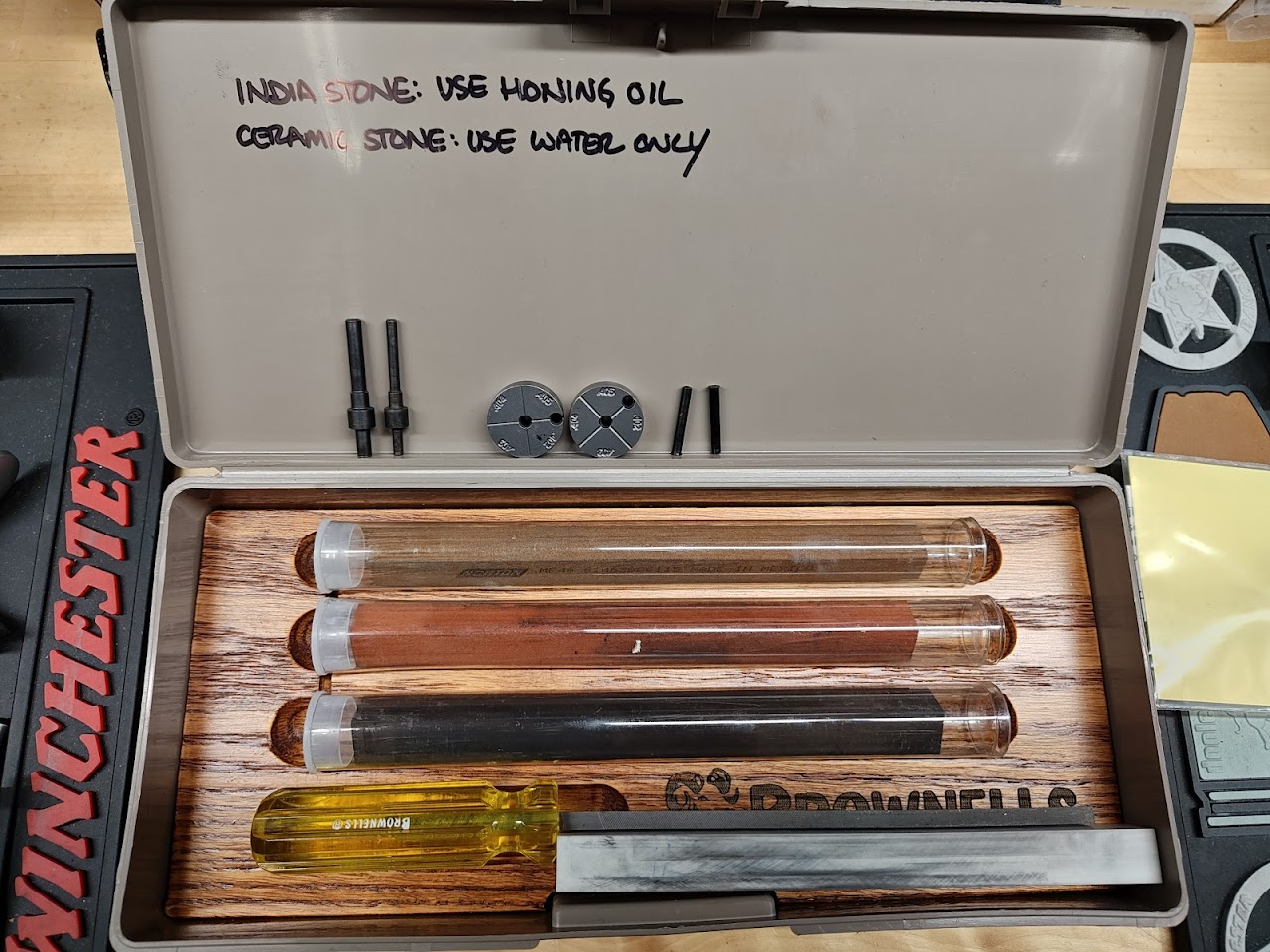 The basic tools I'll use for the sear work on these pistols. Stone and file kit, a sear and hammer offset pin set, and a True Radius kit from Harrison Custom. 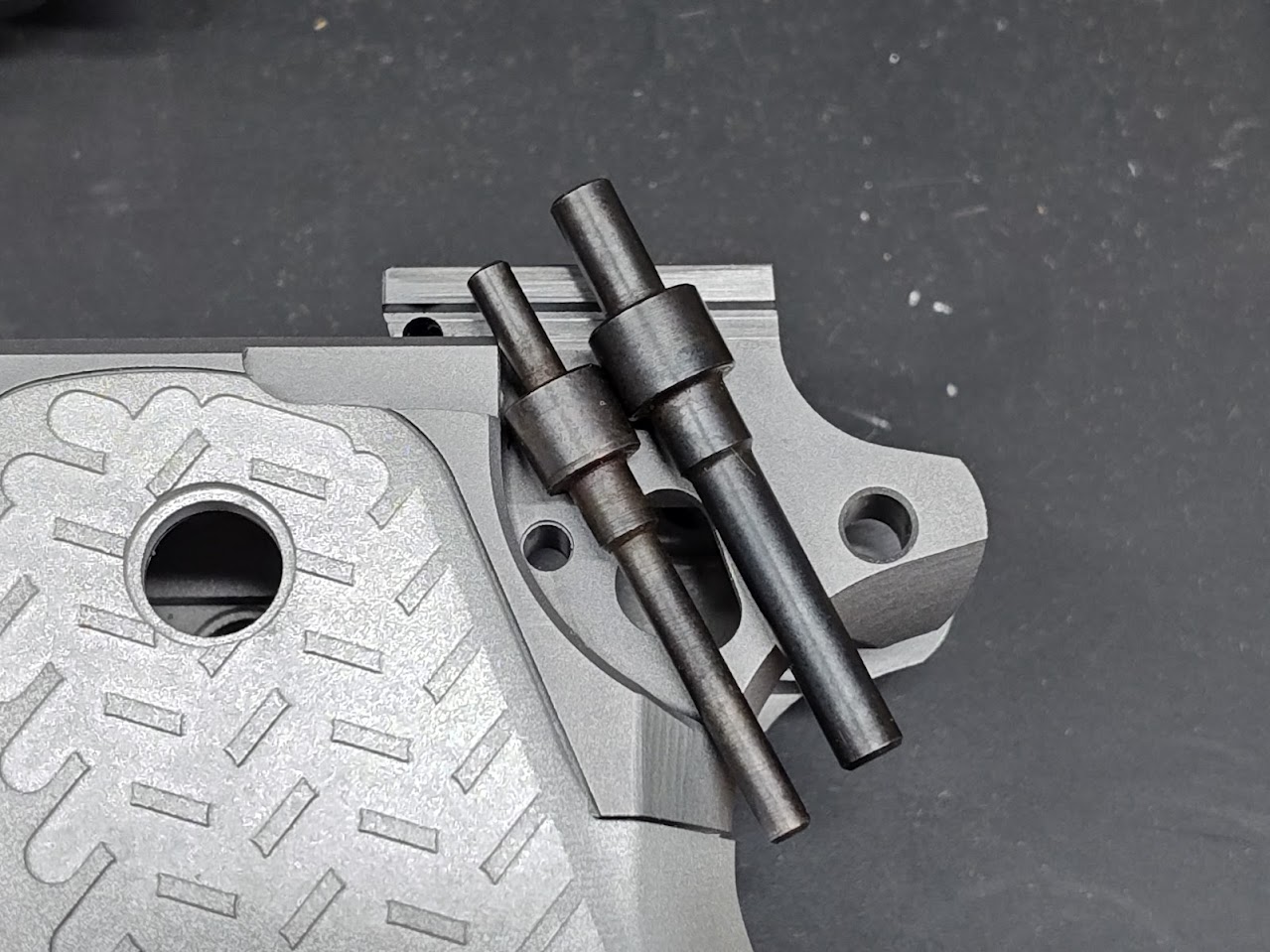 The offset pin set is helpful to observe the interaction between the sear and hammer while working on them, especially when setting the relief cut on the sear. 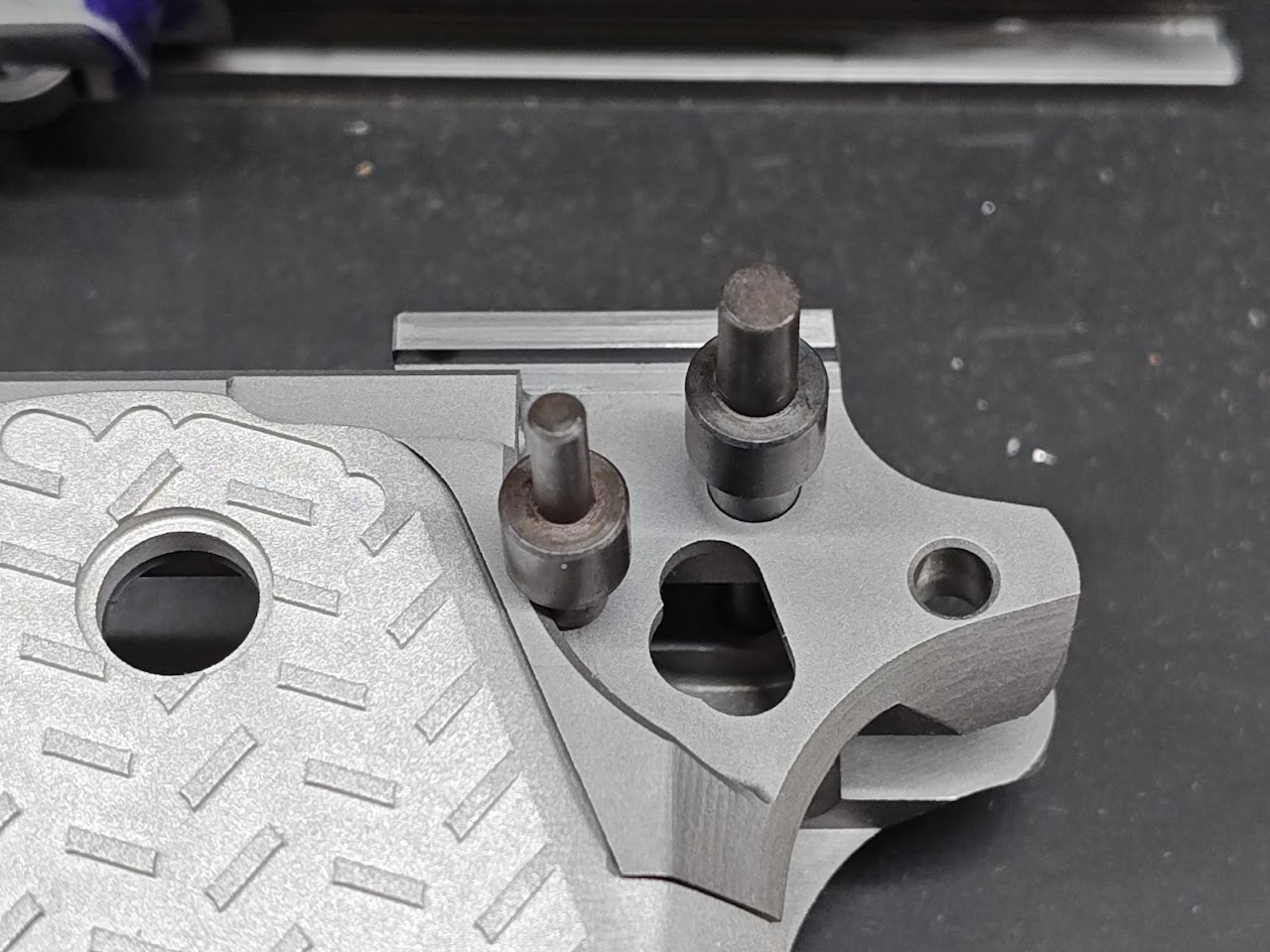 Pins installed. 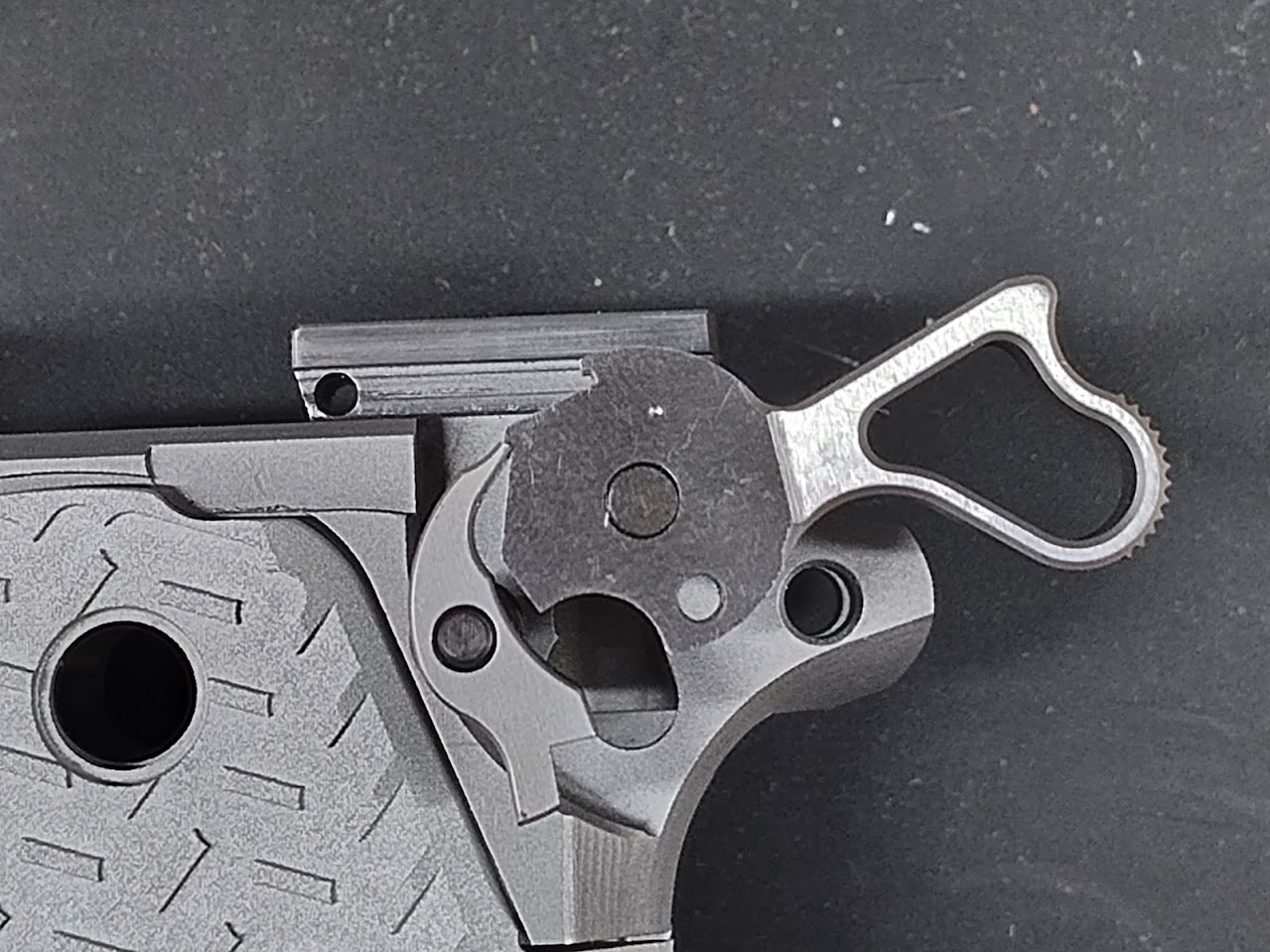 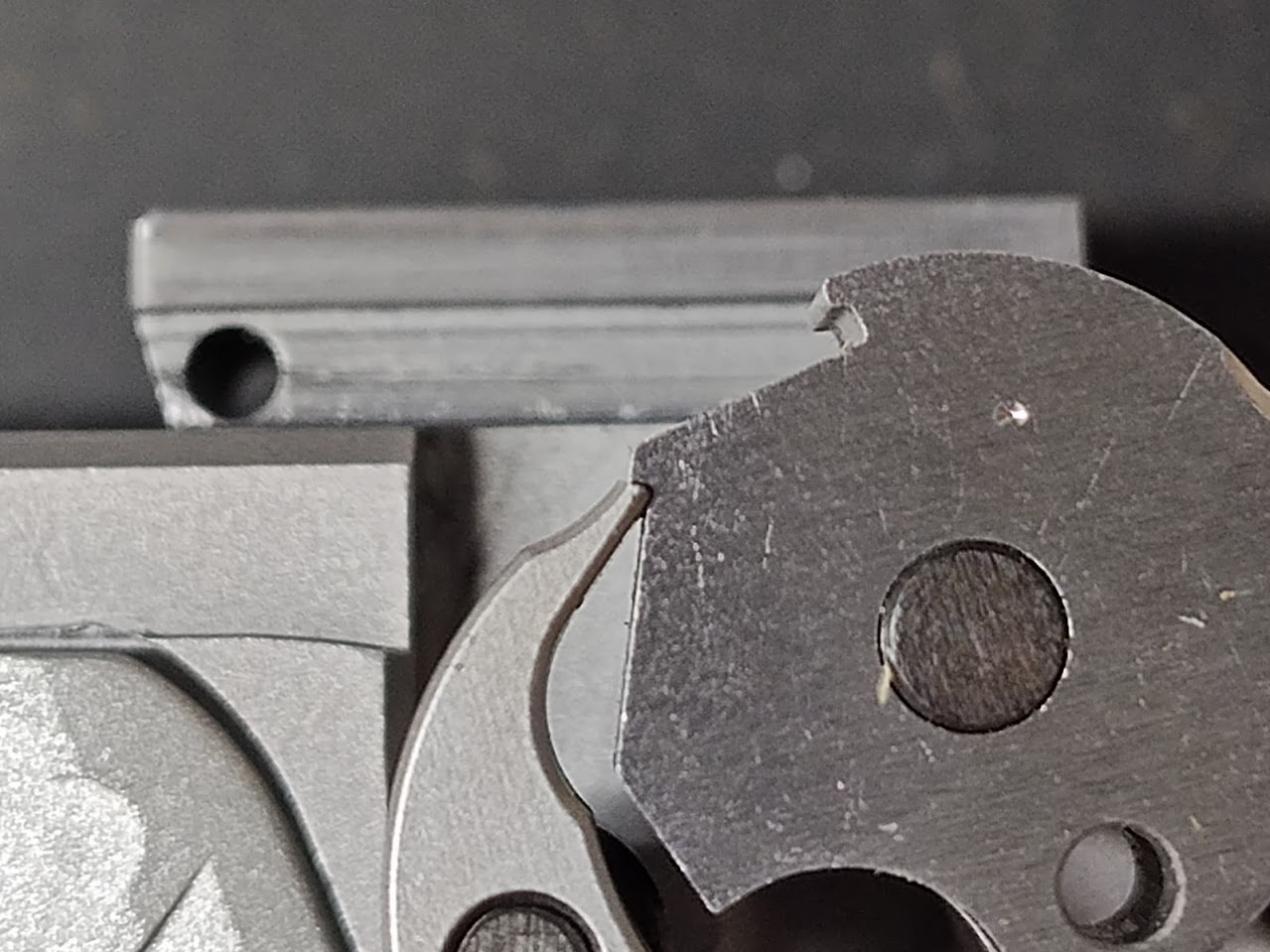 My cell phone is too technologically advanced to give decent macro pictures, I'm learning. This is the sear engagement before any work. 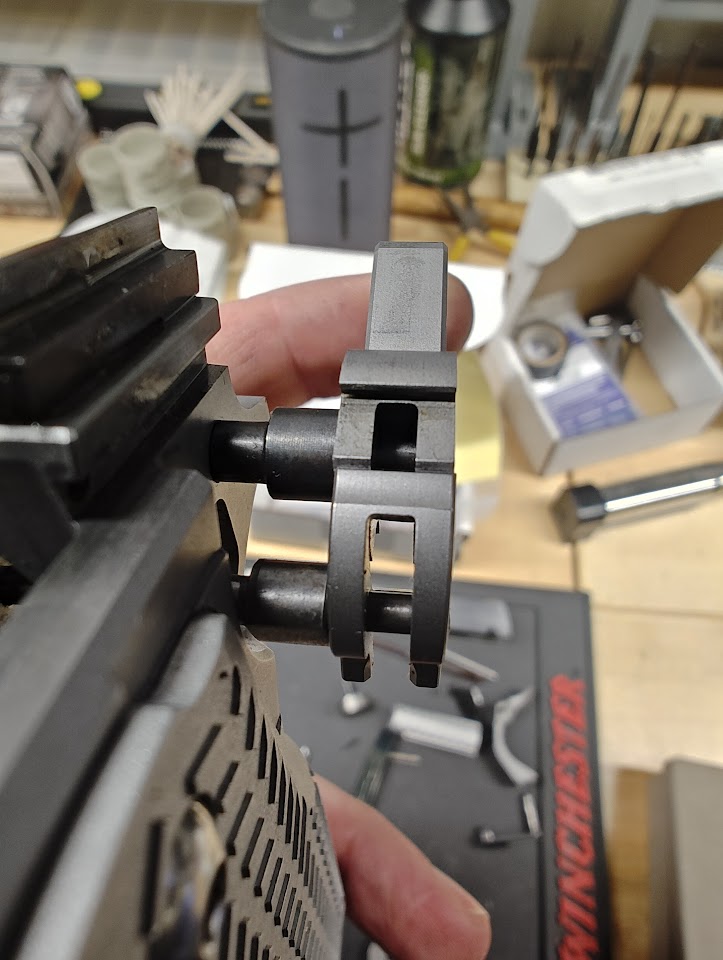 And observed from the front. 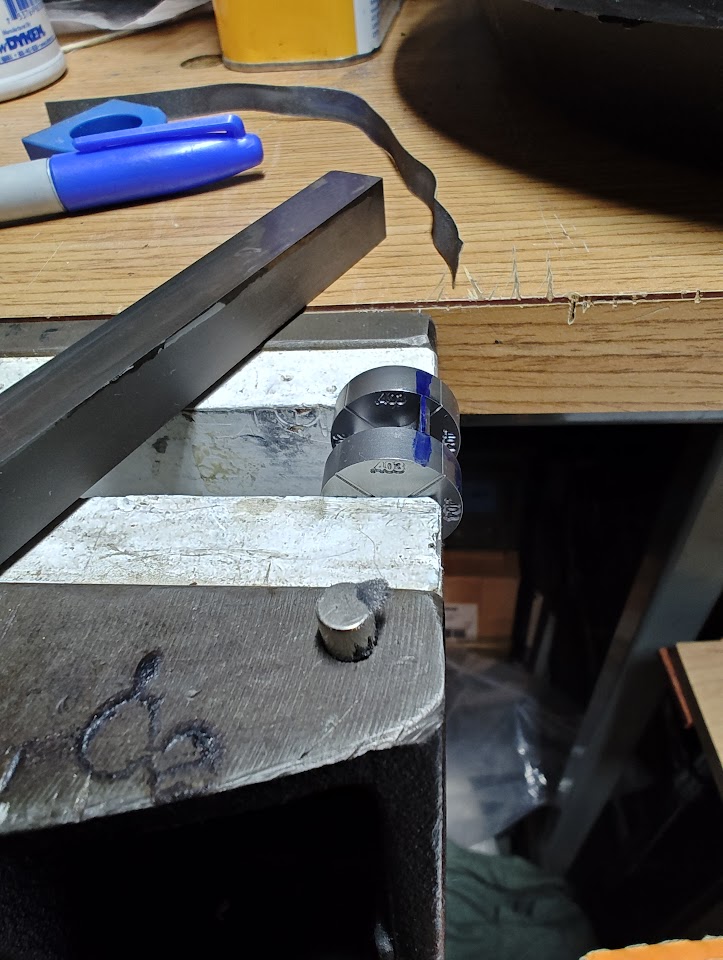 https://www.harrisoncustom.com/images/uploaded/pdf/HD-806%20True%20Radius%20PRO%20Sear%20Jig.pdf This instruction set from Harrison Custom about the True Radius set does a better job than I do at explaining things. I ended up using a few strokes of the fine india stone, then moved to the next smaller radius measurement and bringing it in with the extra fine india stone, then followed off with the ceramic. I'd show pictures, but all the ones I attempted looked pretty bad. 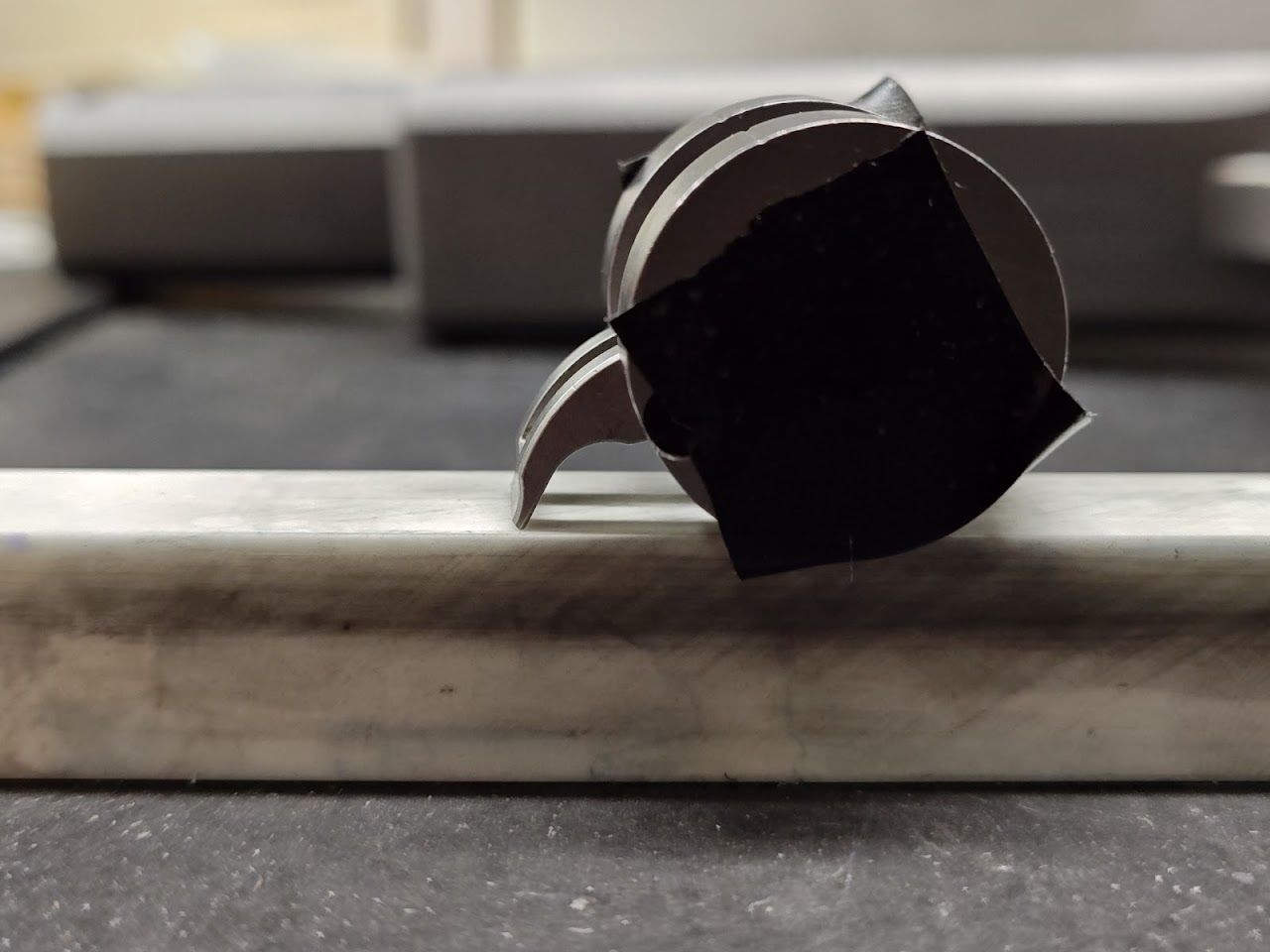 Using just the ceramic stone to set the relief angle, with electrical tape to give a slight offset to preserve the face of the jig. The relief cut is set pretty short, so there is room to take off more if desired. Without playing with the spring, this set both triggers right about 4 pounds. There is still a bit of room to wiggle in, and I'll get the government trigger under 2 pounds before all is said and done. I used the ceramic stone to true and polish the surface of the hammer sear. |
|
|
|
|
The True Radius sear tool is one of the best tools ever.
|
|
|
" We sleep safe in our beds because rough men stand ready in the night to visit violence on those who would do us harm. " -George Orwell
Celer, Silens, Mortalitas "Swift, Silent, Deadly" |
|
@supercomp
Finally took some weights today, just to give a good "before" picture. Government total (including optic mount, slide racker, and thumb rest, but not including the optic or magwell): 56.9oz Government slide (bare): 14.0oz Commander total (including optic mount, but not including optic or magwell): 36.5oz Commander slide (bare): 10.8oz For the recoil spring guide rod on the Commander, I'm using the Atlas commander tool-less guide rod. It's made only for the Atlas slides, which they advertise as being cut down Government slides (which makes for a shorter hood underneath the muzzle, more travel, so more dwell time during recoil, etc.) so it would not work with their recoil spring cap, but does work with a standard 1.25" cap from EGW. I'm not convinced that the Atlas solution is necessary, but it's something to consider if range testing shows a dwell time problem that can't be fixed with springs. |
|
|
|
|
cool!
|
|
|
|
|
Outstanding thread! Looking forward to seeing these come together.
You are a man of patience and your work looks incredible. |
|
|
Slow is smooth. Smooth is fast.
|
|
Had the opportunity to get to the range today, so I threw in the extractors with a rough rough springing. The claws of the extractor have had no work done to them (they'll eventually get some radii and polishing), the ejectors still have not been cut to length or tuned, the disconnectors are still tight, and other details.
There were many failures to eject and feed, as expected. The barrels feel properly tuned. There is no galling to suggest timing or lockup issues, but more testing will confirm that. No accuracy testing. I didn't bring out the ransom rest, and neither of them have sights installed. Glad to know they're somewhat functional. One small hurdle down! |
|
|
|
|
Can you go into thumb safety fitting a bit more? All of the Atlas videos I have watched only mention using a #2 file and taking down enough material on the small leg of the "L" on the sear interface lug. Following Atlas' instructions, I was able to fit my thumb safety and pass all safety/function tests. You mention marking the lug and taking note of contact both in the safe and fire positions. Just curious to see if I am missing anything. I'm using an Atlas ambi carry thumb safety if that makes any difference.
|
|
|
|
|
Awesome
|
|
|
Here I am, Here I remain
|
|
Originally Posted By Advance: Can you go into thumb safety fitting a bit more? All of the Atlas videos I have watched only mention using a #2 file and taking down enough material on the small leg of the "L" on the sear interface lug. Following Atlas' instructions, I was able to fit my thumb safety and pass all safety/function tests. You mention marking the lug and taking note of contact both in the safe and fire positions. Just curious to see if I am missing anything. I'm using an Atlas ambi carry thumb safety if that makes any difference. View Quote @Advance That "L" area is where the majority of filing is done. I don't think the type of safety (paddle size, ambi, etc) matters since the ambi-side doesn't interface directly with the safety, and the lug on the safety should be pretty close to the same across manufacturers. After the hammer, sear and disconnector are fitted, then install the safety. Make sure the safety fits to the frame (no internals, see that it fits in then goes all the way up and down without snags. If it snags, relieve the gap between the flat of the safety that rides against the outside of the frame, and the lug that extends into the frame. Then fit the safety to the sear and hammer. Have the internals already installed, but keep the grip safety off so you can see what's going on. Push the safety into the frame until it bottoms out against the sear. Through the area where the grip safety would be, you can see where the sear is physically preventing the safety from entering the frame (on that "L" ledge.) You can use sharpie or dykem or some other layout fluid to see a physical impression where the safety hits. File away most of that portion of the safety, then slowly walk up to a final fit just to get the safety to fit into the frame. Now the safety will fit into the frame, but it's blocked by the sear from rotating up or down. I'll put sharpie on the filed edge, then push the safety up. If there is a wear mark, I file it a little, then repeat the process. Only remove material from where the sear is hitting the safety and rubbing off the sharpie. If you remove too much during this part of fitting, you deactivate your safety. This can be recovered from by peening out some material, but it's not ideal. Once I have full range of motion to the safe position, I repeat again going down into the safety-off position. Once the safety bottoms out, I test whether the safety actually gave clearance for the sear to move freely by pressing the trigger to drop the hammer (no springs installed.) If the sear hangs or doesn't allow the hammer to fall, I repeat the process with sharpie. Hope this makes sense. It makes sense to me, but I'm visualizing it while typing it out... |
|
|
|
|
More testing.
After adjusting the tension down on the extractor and no other work (though there's still lots to do) the Gov went out to the range today for about 100 rounds. Absolutely flawless today, which was very pleasantly surprising. Hopefully some more work gets done this weekend. |
|
|
|
|
Dropped off at the machinist for some rendering, then milling of the slides and frames. No more updates for a while, I think.
|
|
|
|
 Win a FREE Membership!
Win a FREE Membership!
Sign up for the ARFCOM weekly newsletter and be entered to win a free ARFCOM membership. One new winner* is announced every week!
You will receive an email every Friday morning featuring the latest chatter from the hottest topics, breaking news surrounding legislation, as well as exclusive deals only available to ARFCOM email subscribers.
AR15.COM is the world's largest firearm community and is a gathering place for firearm enthusiasts of all types.
From hunters and military members, to competition shooters and general firearm enthusiasts, we welcome anyone who values and respects the way of the firearm.
Subscribe to our monthly Newsletter to receive firearm news, product discounts from your favorite Industry Partners, and more.
Copyright © 1996-2024 AR15.COM LLC. All Rights Reserved.
Any use of this content without express written consent is prohibited.
AR15.Com reserves the right to overwrite or replace any affiliate, commercial, or monetizable links, posted by users, with our own.

